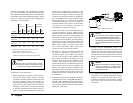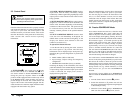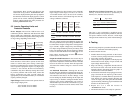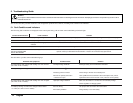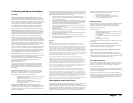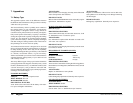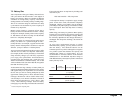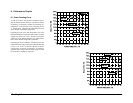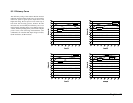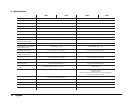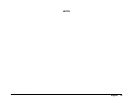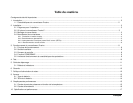
7.2 Battery Size
Just as important as the type of battery selected for use
with your Xantrex Prosine Inverter is the subject of
battery size (capacity). There are a number of different
standards for rating battery capacity. Automotive
starting batteries are normally rated by cranking amps.
This is not a relevant rating for continuous use. Deep
cycle batteries are rated either by reserve capacity in
minutes or by amp-hours.
Battery reserve capacity is a measure of how long a
battery can deliver a certain amount of current—usually
25 amps. For example, a battery with a reserve capacity
of 180 minutes can deliver 25 amps for 180 minutes
before it is completely discharged.
Amp-hour capacity is a measure of how many amps a
battery can deliver for a specified length of time—
usually 20 hours. For example, a typical marine or RV
battery rated for 100 amp hours can deliver 5 amps for
20 hours. (5 amps x 20 hours = 100 amp hours)
You can expect performance from the inverter to suffer
with the use of a small, low amp-hour rated battery
(for example, 50 Ah). Even if your battery is in excellent
shape and fully charged you will likely experience
poor surge power performance and unsatisfactory
operating time with anything but a small AC load.
Xantrex recommends a minimum battery size of 200
Ah for moderate loads (less than 1000 W) and greater
than 400 Ah for heavy loads.
To determine how large a battery or battery bank you
require for equipment running from the inverter, simply
add together the power requirements for all electrical
devices that you will be running multiplied by their
approximate running times in hours between battery
recharges. Each device will be rated in either watts,
volts and amps, or VA. For this calculation, all three of
these ratings are equivalent (i.e. volts x amps = watts
= VA). The following example, based on battery
recharging every three days, illustrates the calculation:
1
Power Consumption x Operating Time
Convert the watt hours to amp hours by dividing total
watt hours by 10:
1495 watt hours/10 = 149.5 amp hours
A 150 amp hour battery is required to supply enough
power for the above loads, and become completely
discharged. Ideally, you normally want to discharge
your battery to only 50% capacity, so for the above loads,
you would require about 300 amp hours of battery
capacity.
When sizing your battery, be generous. More capacity
is better since you will have more reserve capacity, and
your battery will not be discharged as deeply. Battery
life is directly dependent on how deeply the battery is
discharged. The deeper the discharge, the shorter the
battery life.
As your power requirements increase, to obtain
sufficient battery capacity, you may need to use more
than one battery. Two identical batteries can be
connected positive to positive and negative to negative
in a parallel system that doubles the capacity and
maintains the voltage of a single battery. It is not
recommended to connect batteries from different
manufacturers or with different amp-hour ratings or
with different battery electrolytes in parallel. Decreased
battery life may result.
daoL
rewoP
noitpmusnoC
emiTgnitarepO
sruohttaW
1
RCV&VTW511srh3
)yadreprh1(
543
eeffoC
rekaM
W057rh1
)yadrep.nim02(
057
evaworciM
nevO
W008srh5.0
)yadrep.nim01(
004
LA
TOT5941
English 15
Xantrex Prosine Inverter Owner’s Manual




